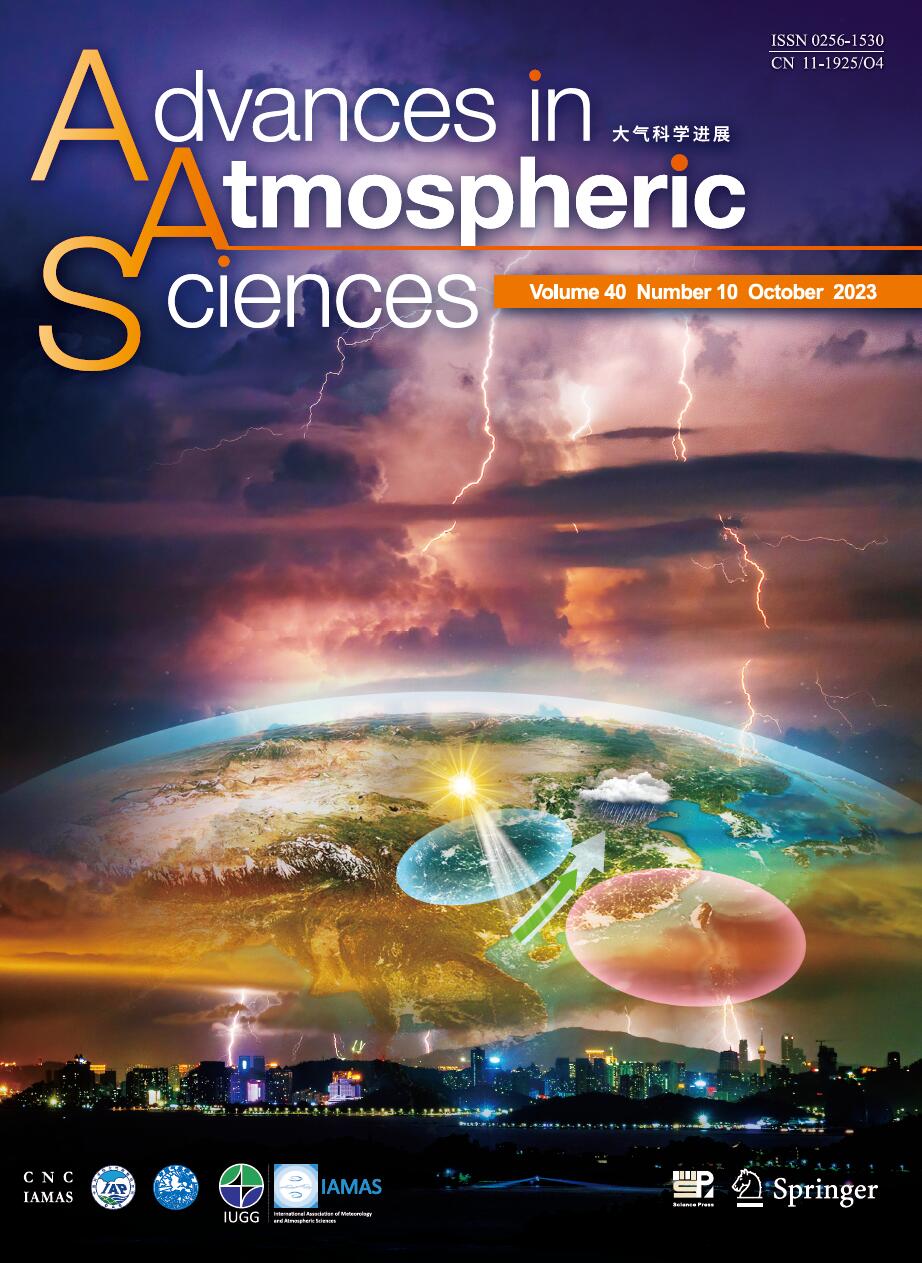| [1] |
LIU Yu, LI Weiliang, ZHOU Xiuji, I.S.A.ISAKSEN, J.K.SUNDET, HE Jinhai,
2003: The Possible Influences of the Increasing Anthropogenic Emissions in India on Tropospheric Ozone and OH, ADVANCES IN ATMOSPHERIC SCIENCES, 20, 968-977.
doi: 10.1007/BF02915520
|
| [2] |
LIU Yu, I.S.A.ISAKSEN, J.K.SUNDET, ZHOU Xiuji, MA Jianzhong,
2003: Impact of Aircraft NOx Emission on NOx and Ozone over China, ADVANCES IN ATMOSPHERIC SCIENCES, 20, 565-574.
doi: 10.1007/BF02915499
|
| [3] |
WANG Geli, YANG Peicai,
2006: On the Nonlinear Response of Lower Stratospheric Ozone to Nox and ClOx Perturbations for Different CH4 Sources, ADVANCES IN ATMOSPHERIC SCIENCES, 23, 750-757.
doi: 10.1007/s00376-006-0750-6
|
| [4] |
Wang Guiqin,
1990: Simulation of the Influence of Ion-Produced NOX and HOX Radicals on the Antarctic Ozone Depletion with a One-Dimensional Model, ADVANCES IN ATMOSPHERIC SCIENCES, 7, 98-103.
doi: 10.1007/BF02919172
|
| [5] |
SUN Zhian, WANG Xiaoyun, ZENG Xianning,
2006: Radiative Forcing of SO2 and NOx: A Case Study in Beijing, ADVANCES IN ATMOSPHERIC SCIENCES, 23, 317-322.
doi: 10.1007/s00376-006-0317-6
|
| [6] |
Sophie GODIN-BEEKMANN, Irina PETROPAVLOSKIKH, Stefan REIS, Paul NEWMAN, Wolfgang STEINBRECHT, Markus REX, Michelle L. SANTEE, Richard S. ECKMAN, Xiangdong ZHENG, Matthew B. TULLY, David S. STEVENSON, Paul YOUNG, John PYLE, Mark WEBER, Johanna TAMMINEN, Gina MILLS, Alkis F. BAIS, Clare HEAVISIDE, Christos ZEREFOS,
2017: The Quadrennial Ozone Symposium 2016, ADVANCES IN ATMOSPHERIC SCIENCES, 34, 283-288.
doi: 10.1007/s00376-016-6309-2
|
| [7] |
SU Mingfeng, LIN Yunping, FAN Xinqiang, PENG Li, ZHAO Chunsheng,
2012: Impacts of Global Emissions of CO, NOx, and CH4 on China Tropospheric Hydroxyl Free Radicals, ADVANCES IN ATMOSPHERIC SCIENCES, 29, 838-854.
doi: 10.1007/s00376-012-1229-2
|
| [8] |
Qi LI, Fengxia GUO, Xiaoyu JU, Ze LIU, Mingjun GAN, Kun ZHANG, Binbin CAI,
2023: Estimation of Lightning-Generated NOx in the Mainland of China Based on Cloud-to-Ground Lightning Location Data, ADVANCES IN ATMOSPHERIC SCIENCES, 40, 129-143.
doi: 10.1007/s00376-022-1329-6
|
| [9] |
WANG Geli, YANG Peicai, LIU Chuanxi, LIU Yi, LU Daren,
2010: Impacts of Future NOx and CO Emissions on Regional Chemistry and Climate over Eastern China, ADVANCES IN ATMOSPHERIC SCIENCES, 27, 750-760.
doi: 10.1007/s00376-009-9101-8
|
| [10] |
Zhou Libo, Zou Han, Ji Chongping, Wang Wei, Jian Yongxiao,
2001: The Scandinavia Ozone Loss and Surface Heating, ADVANCES IN ATMOSPHERIC SCIENCES, 18, 454-466.
doi: 10.1007/BF02919324
|
| [11] |
Sophie GODIN-BEEKMANN, Irina PETROPAVLOSKIKH, Stefan REIS, Paul NEWMAN, Wolfgang STEINBRECHT, Markus REX, Michelle L. SANTEE, Richard S. ECKMAN, Xiangdong ZHENG, Matthew B. TULLY, David S. STEVENSON, Paul YOUNG, John PYLE, Mark WEBER, Johanna TAMMINEN, Gina MILLS, Alkiviadis F. BAIS, Clare HEAVISIDE, Christos ZEREFOS,
2018: Erratum to: The Quadrennial Ozone Symposium 2016, ADVANCES IN ATMOSPHERIC SCIENCES, 35, 368-369.
doi: 10.1007/s00376-018-0001-7
|
| [12] |
L.S. Hingane,
1989: Role of Ozone in the Sodium and Hydroxyl Nightglow, ADVANCES IN ATMOSPHERIC SCIENCES, 6, 89-98.
doi: 10.1007/BF02656920
|
| [13] |
V. N. R. Mukku, C. S. Bhosale,
1991: Ozone during Stratospheric Warmings at Uccle, ADVANCES IN ATMOSPHERIC SCIENCES, 8, 251-255.
doi: 10.1007/BF02658099
|
| [14] |
XIE Pinhua, LIU Wenqing, FU Qiang, WANG Ruibin, LIU Jianguo, WEI Qingnong,
2004: Intercomparison of Nox,SO2,O3,and Aromatic Hydrocarbons Measured by a Commercial DOAS System and Traditional Point Monitoring Techniques, ADVANCES IN ATMOSPHERIC SCIENCES, 21, 211-219.
doi: 10.1007/BF02915707
|
| [15] |
QU Yu, AN Junling, LI Jian, CHEN Yong, LI Ying, LIU Xingang, and HU Min,
2014: Effects of NOx and VOCs from Five Emission Sources on Summer Surface O3 over the Beijing-Tianjin-Hebei Region, ADVANCES IN ATMOSPHERIC SCIENCES, 31, 787-800.
doi: 10.1007/s00376-013-3132-x
|
| [16] |
SUN Yang, WANG Yuesi, ZHANG Changchun,
2010: Vertical Observations and Analysis of PM2.5, O3, and NOx at Beijing and Tianjin from Towers during Summer and Autumn 2006, ADVANCES IN ATMOSPHERIC SCIENCES, 27, 123-136.
doi: 10.1007/s00376-009-8154-z
|
| [17] |
Zou Han, Ji Chongping, Zhou Libo, Wang Wei, Jian Yongxiao,
2001: ENSO Signal in Total Ozone over Tibet, ADVANCES IN ATMOSPHERIC SCIENCES, 18, 231-238.
doi: 10.1007/s00376-001-0016-2
|
| [18] |
Wang Hongqi, Zhou Xiuji,
1984: THE PHOTODISSOCIATION COEFFICIENTS OF OZONE AND OXYGEN IN THE CLOUDY TURBID ATMOSPHERE, ADVANCES IN ATMOSPHERIC SCIENCES, 1, 277-.
doi: 10.1007/BF02678140
|
| [19] |
ZHANG Meigen, XU Yongfu, Itsushi UNO, Hajime AKIMOTO,
2004: A Numerical Study of Tropospheric Ozone in the Springtime in East Asia, ADVANCES IN ATMOSPHERIC SCIENCES, 21, 163-170.
doi: 10.1007/BF02915702
|
| [20] |
Zou Han, Ji Chongping, Zhou Libo,
2000: QBO Signal in Total Ozone over Tibet, ADVANCES IN ATMOSPHERIC SCIENCES, 17, 562-568.
doi: 10.1007/s00376-000-0019-4
|















 AAS Website
AAS Website 
 AAS WeChat
AAS WeChat 
 DownLoad:
DownLoad: